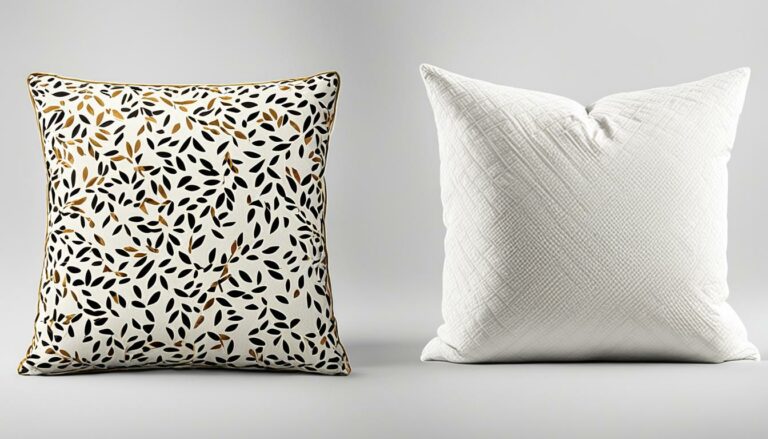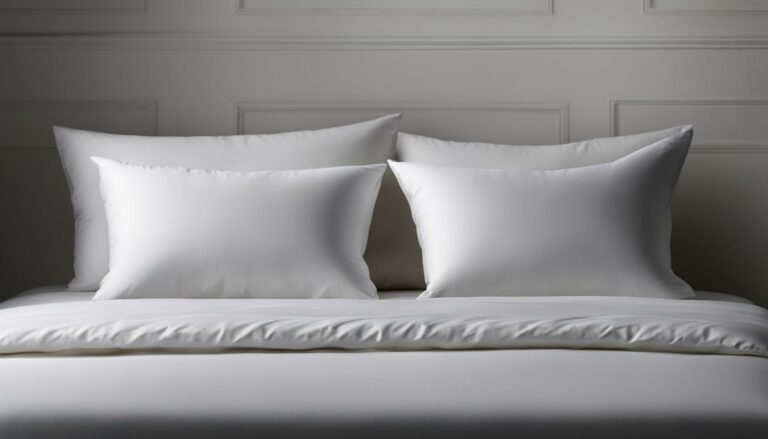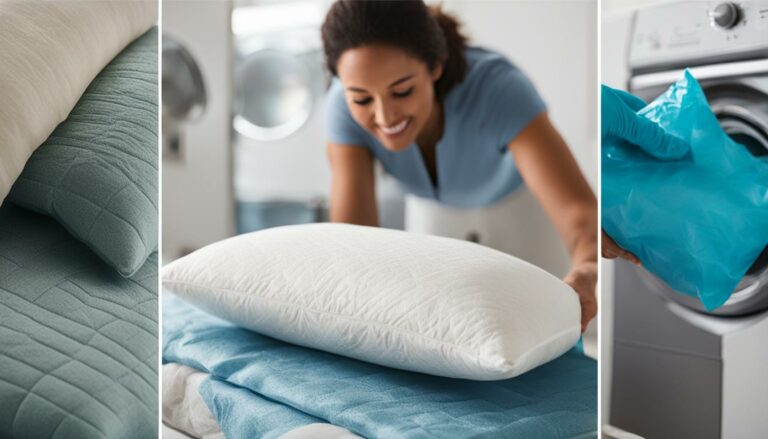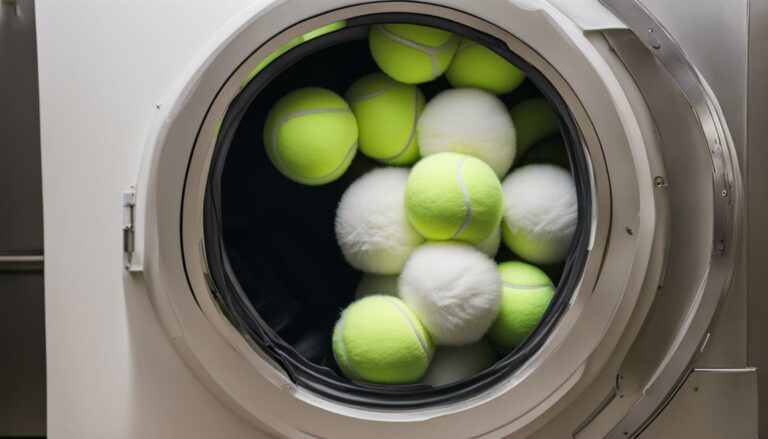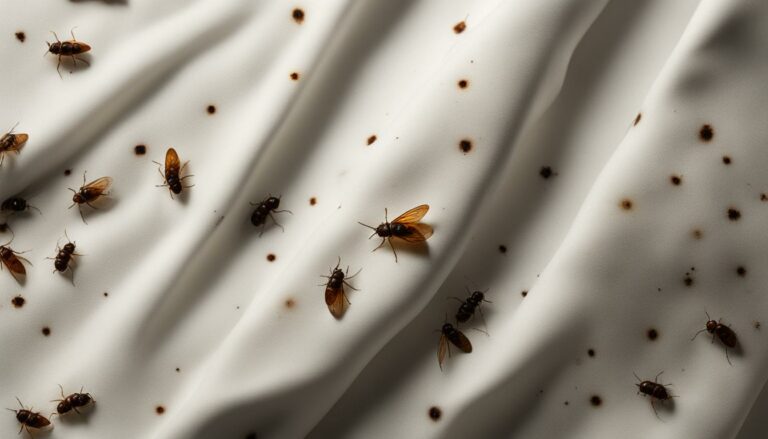Drying Memory Foam Pillows: Is It Safe?
Eric Christie stands as a luminary in the bedding industry, with a career spanning nearly four decades since the early 1980s. His journey through the world of bedding has seen him wear many hats – a manufacturer, designer, and retailer, showcasing his versatility and expertise in Read more...
pillowsandbedsheets.com and its partners may earn a commission if you purchase a product through one of our links
Memory foam pillows have become increasingly popular for their comfort and support. However, when it comes to cleaning them, many people are unsure of the best methods. One common question is whether it is safe to put a memory foam pillow in the dryer. Let’s find out.
Putting a memory foam pillow in the dryer is not recommended. The machine’s harsh movement and heat can damage the foam, causing it to lose its supportive properties. Instead, it is important to use gentle cleaning techniques to keep your memory foam pillow in optimal condition.
Key Takeaways:
- Avoid putting memory foam pillows in the dryer, as the heat and movement can damage the foam.
- Hand washing or spot cleaning is recommended for cleaning memory foam pillows.
- Follow specific instructions for hand washing or spot cleaning from the pillow manufacturer.
How to Hand Wash Memory Foam Pillows
When it comes to washing your memory foam pillows, hand washing is the way to go. This gentle method ensures that your pillows stay clean and well-maintained without causing any damage. Follow these simple steps to wash your memory foam pillows by hand:
-
Remove the cover: Start by removing the cover from the memory foam pillow. Check the care instructions on the label and wash the cover separately according to those guidelines.
-
Prepare the washing solution: Fill a large sink or bathtub with lukewarm water. Add a small amount of gentle detergent and mix it well to create a soapy solution.
-
Submerge the pillow: Place the memory foam pillow in the prepared water and gently press it down to ensure it is fully submerged. Allow it to soak for a few minutes to loosen any dirt or debris.
-
Lightly lather and rinse: Lightly lather the pillow by gently squeezing it and moving it around in the water. Be careful not to agitate or scrub too vigorously, as this can damage the foam. Rinse the pillow thoroughly until the water runs clear.
-
Let it air dry: After rinsing, gently squeeze out any excess water from the pillow. Place the pillow on a flat, well-ventilated surface away from direct heat and sunlight. Allow it to air dry completely before using it again. This process might take up to 24 hours.
Hand washing your memory foam pillows not only helps to keep them clean but also prolongs their lifespan. Remember to always check the care instructions provided by the manufacturer to ensure the best cleaning method for your specific pillow.
How to Spot Clean Memory Foam Pillows
Spot cleaning is a practical alternative for when foam pillows cannot be hand-washed or when a quick turnaround is essential. Follow these cleaning tips for memory foam pillows to keep them fresh and stain-free:
- Step 1: Remove the pillow cover and wash it separately according to the care instructions.
- Step 2: In a clean container, combine mild detergent or dishwashing liquid with lukewarm water.
- Step 3: Moisten a clean white cloth with the detergent solution.
- Step 4: Blot the stained area gently with the cloth, applying light pressure. Avoid rubbing vigorously to prevent damaging the foam.
- Step 5: Continue blotting until the stain is removed. If the stain persists, repeat the process with a fresh mixture of detergent solution.
- Step 6: Rinse the foam pillow with plain water to remove any trace of detergent residue.
- Step 7: Squeeze out excess water from the foam pillow without twisting or wringing it.
- Step 8: Place the pillow on a clean, dry towel and gently press to absorb remaining moisture.
- Step 9: Allow the pillow to air dry completely in a well-ventilated area. Ensure it is not exposed to direct sunlight or heat sources that could damage the foam.
Remember to always check the care instructions provided by the manufacturer as some foam pillows may have specific cleaning guidelines.
Spot Cleaning Tips:
Tip 1: Act quickly when spills or stains occur to prevent them from setting into the foam.
Tip 2: Test the detergent solution on a small, inconspicuous area of the pillow first to ensure it doesn’t cause discoloration.
Tip 3: Use a clean, white cloth to avoid transferring dyes or colors onto the foam pillow.
Tip 4: Avoid using harsh chemicals, bleach, or strong cleaning agents as they can damage the foam.
Tip 5: For stubborn stains, consider using a specialized foam cleaner designed for memory foam products.
By following these spot cleaning methods, you can effectively remove stains from your memory foam pillows and maintain their cleanliness and comfort for years to come.
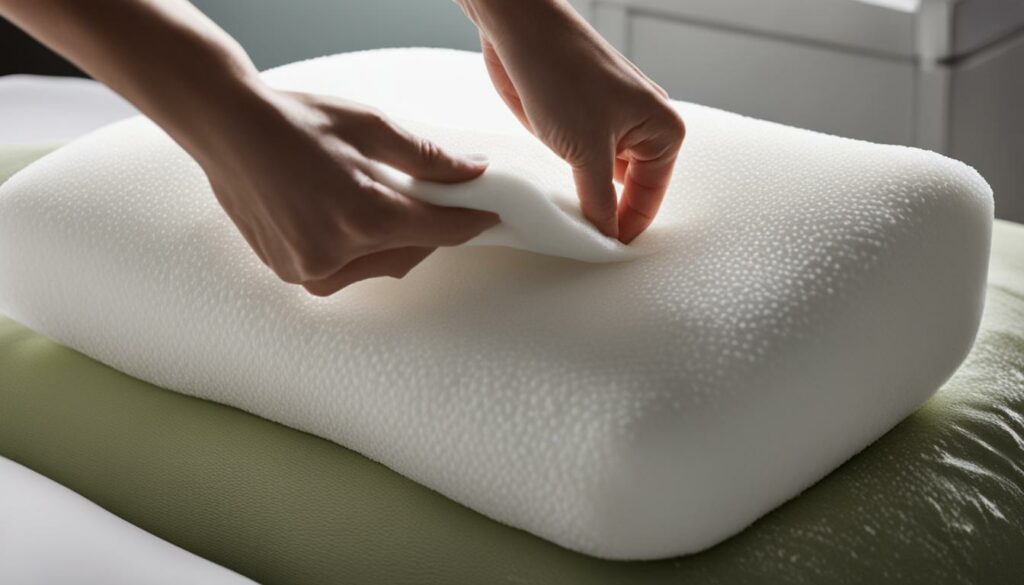
How Often Should You Wash Memory Foam Pillows?
Cleaning your memory foam pillows regularly is essential to maintain their hygiene and extend their lifespan. The frequency of washing depends on several factors, such as individual preferences and the environment in which the pillows are used. However, it is generally recommended to wash memory foam pillows every three months to prevent the accumulation of dirt, dust, and allergens.
To further protect your pillows, it is advisable to clean the pillow cover more frequently, approximately once a month. The pillow cover acts as a barrier, shielding the memory foam from external contaminants. Keeping the cover clean ensures a cleaner and healthier sleep environment.
In between washes, using a protective cover can provide an additional layer of defense against moisture, sweat, oils, and stains. The protective cover can be easily removed and washed, helping to keep your memory foam pillows cleaner for longer periods and reducing the need for frequent washing.
Maintaining regular cleaning frequencies not only promotes better sleep hygiene but also helps to preserve the integrity and performance of your memory foam pillows over time.
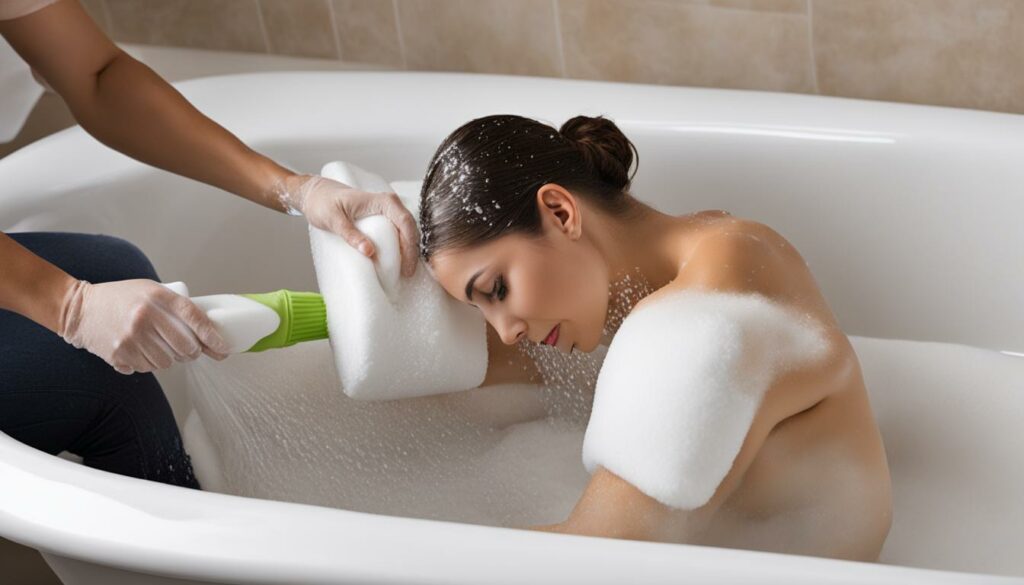
| Memory Foam Pillow | Pillow Cover | |
|---|---|---|
| Cleaning Frequency | Every three months | Approximately once a month |
| Benefits | Prevents accumulation of dirt and allergens | Keeps the pillow cleaner and extends its lifespan |
| Additional Tips |
|
|
How to Dry a Foam Pillow
After washing, memory foam pillows should be air dried on a flat, well-ventilated surface away from direct heat and sunlight. It is not safe to put memory foam pillows in the dryer as the high heat can damage the foam. The drying process can take up to 24 hours, and using a fan can help speed up the drying time.
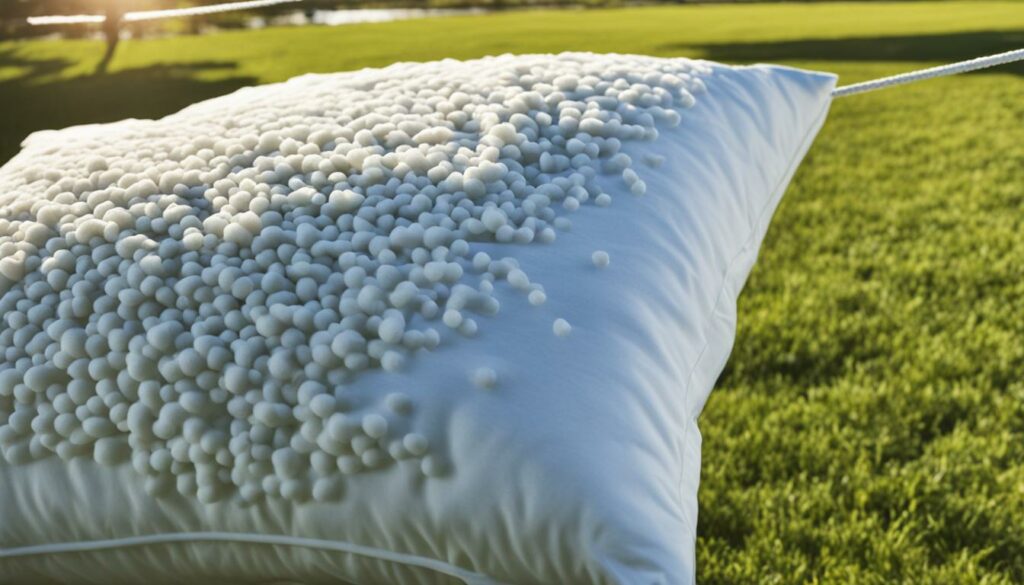
When it comes to drying memory foam pillows, air drying is the recommended method. This ensures that the foam maintains its shape and support without being exposed to excessive heat or moisture. Here is a step-by-step guide on how to air dry your memory foam pillows:
- After washing your memory foam pillow, gently squeeze out any excess water.
- Place the pillow on a clean, dry towel to absorb any remaining moisture.
- Find a flat surface, such as a table or countertop, that is away from direct heat and sunlight.
- Position the pillow on the surface, allowing air to circulate around it.
- If possible, use a fan to create airflow and expedite the drying process.
- Rotate the pillow every few hours to ensure even drying.
- Allow the pillow to dry completely, which can take up to 24 hours.
It’s important to note that memory foam pillows should not be exposed to direct heat sources, such as hair dryers or radiators, as this can cause damage to the foam. Also, avoid using the pillow until it is completely dry to prevent any potential mold or mildew growth.
How Can You Freshen Up Memory Foam Pillows?
To keep your memory foam pillows feeling fresh and smelling pleasant, there are a few simple tricks you can try. By removing dust and crumbs and eliminating odors, you can maintain the cleanliness and comfort of your pillows.
If you notice your memory foam pillows accumulating dust and crumbs, it’s time for a quick cleanup. Use the upholstery attachment of your vacuum cleaner to gently suction away any debris from the surface of the pillows. This will help to keep them clean and free from allergens.
Another effective way to freshen up memory foam pillows is by airing them out in the sun. Simply take your pillows outside on a sunny day and let them bask in the natural light and fresh air for an hour or two. The UV rays from the sun will help to eliminate any unwanted odors that may have developed over time.
To visualize this process:
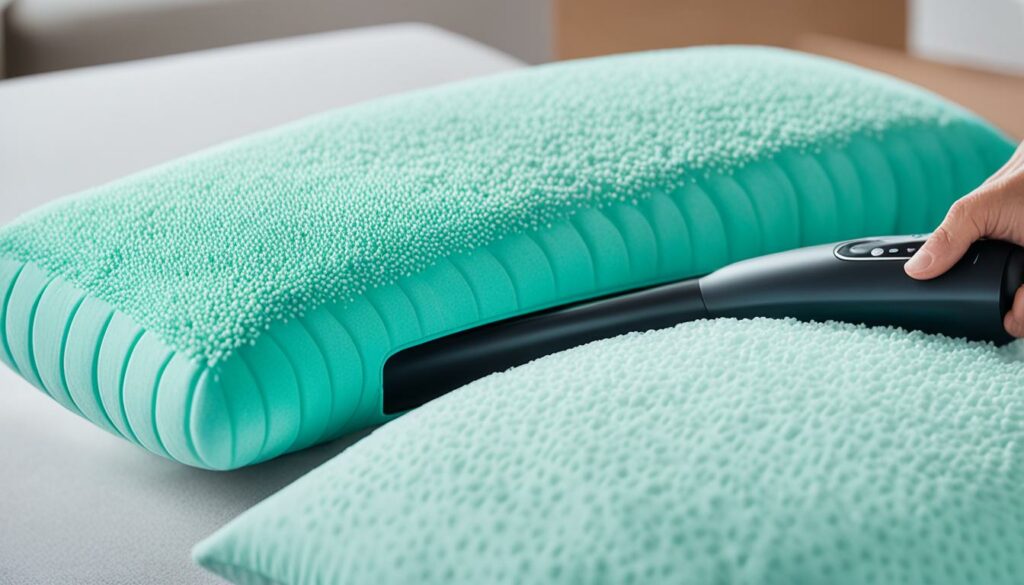 |
| The sun’s rays can help eliminate odors from memory foam pillows. |
By regularly freshening up your memory foam pillows, you can ensure that they remain clean, comfortable, and free from unpleasant odors.
How to Remove Stains from Memory Foam Pillows
If a stain occurs on your memory foam pillow, it’s important to spot clean it immediately to prevent the stain from setting. Follow these steps to effectively remove stains from your memory foam pillow:
- Remove all pillowcases and covers from the pillow.
- Blot the stain gently with a clean cloth to absorb any excess liquid or residue.
- Create a mixture of lukewarm water and a gentle detergent.
- Dip a clean cloth into the mixture and gently rub the stain in a circular motion. Be careful not to saturate the pillow with too much water.
- Continue rubbing the stain until it fades away.
- Rinse the area with clean water to remove any soap residue.
- Air dry the pillow completely in a well-ventilated area, away from direct heat and sunlight. This ensures that the pillow maintains its shape and doesn’t develop any odors.
Remember, it’s essential to address stains promptly and avoid using harsh cleaning agents or excessive water, as they can damage the memory foam material. By following these stain removal steps, you can keep your memory foam pillow clean and comfortable for a restful sleep.
How to Get Rid of Sweat Smell on Memory Foam Pillows
If you notice a lingering sweat smell on your memory foam pillow, don’t worry – there’s a simple solution to freshen it up. One effective method is to use baking soda, a natural deodorizer that helps eliminate odors.
Here’s a step-by-step guide:
- Begin by sprinkling a generous amount of baking soda on one side of the pillow.
- Allow the pillow to sit in the sun for 1-2 hours. The sunlight will help activate the baking soda and neutralize the sweat smell.
- After the sun exposure, use the upholstery attachment of a vacuum cleaner to thoroughly remove the baking soda from the pillow.
- Flip the pillow over and repeat the process on the other side.
By following these steps, you can effectively remove the sweat smell from your memory foam pillow and enjoy a fresh and clean sleeping experience.
Remember, it’s important to regularly maintain and clean your memory foam pillows to keep them fresh and odor-free. If you want to learn more about cleaning and caring for memory foam pillows, continue reading the next section.
How to Deep Clean Memory Foam Pillows
When it comes to keeping your memory foam pillows fresh and clean, regular washing is important. However, sometimes a more thorough cleaning is necessary to remove deep stains and odors. Deep cleaning memory foam pillows can help restore their original freshness and extend their lifespan. Here’s a step-by-step guide on how to deep clean your memory foam pillows:
- Start by filling a sink or bath with cold water. Add a small amount of gentle detergent to create a cleaning solution. Avoid using harsh chemicals or bleach, as they can damage the foam.
- Submerge the memory foam pillow in the water and gently squeeze it to allow the cleaning solution to penetrate the fibers.
- Let the pillow soak for about 15 minutes to loosen dirt and stains. If there are specific areas that require extra attention, you can gently massage the pillow with your hands.
- After the soaking period, drain the sink or bath and refill it with clean water. Squeeze the pillow gently to rinse out the detergent. Repeat this step until the water runs clear and all soap residue is removed.
- Once the pillow is thoroughly rinsed, gently press out the excess water. Avoid wringing or twisting the pillow, as this can damage the foam.
- To ensure proper drying, place the pillow on a dry towel or clean surface. Gently shape the pillow back to its original form and allow it to air dry completely. Avoid exposing the pillow to direct heat or sunlight, as this can cause damage.
Deep cleaning your memory foam pillows every few months can help remove deep-seated stains and odors, leaving them fresh and revitalized. Remember to always follow the manufacturer’s instructions and guidelines for cleaning your specific memory foam pillow.
Check out the illustration below for a visual guide on how to deep clean memory foam pillows:
By following these steps, you can ensure that your memory foam pillows stay clean, fresh, and comfortable for a long time.
Can Memory Foam Pillows Get Mouldy?
If moisture seeps into memory foam pillows and they are not dried properly, mould and mildew can form.
It is important to allow memory foam pillows to dry completely after washing to prevent mould growth.
To protect your memory foam pillow from mould growth, follow these steps:
- After washing, squeeze out as much water as possible from the pillow.
- Place the pillow on a flat and well-ventilated surface.
- Avoid direct sunlight and excessive heat, as they can damage the foam.
- Use a fan or open windows to promote air circulation and speed up the drying process.
- Ensure that both the pillow and its cover are completely dry before using or storing them.
Note: Proper drying is crucial to prevent mould and maintain the longevity of your memory foam pillow.
Can Bed Bugs Live in Memory Foam Pillows?
Memory foam acts as a barrier to unwanted creatures such as bed bugs and dust mites, making it a popular choice for those concerned about allergens and pests. However, it is important to note that while memory foam can help prevent bed bugs from burrowing deep into the material, it is still possible for these resilient pests to live on the surface of memory foam mattresses and pillows.
To prevent bed bug infestations in your memory foam pillows, it is crucial to maintain proper hygiene and take proactive measures:
- Regularly wash all bedding, including pillowcases and covers, following the manufacturer’s instructions. This helps eliminate any potential bed bugs or eggs.
- Vacuum your memory foam pillows regularly to remove any bed bugs or debris that may be present on the surface.
- Consider using a bed bug-proof pillow encasement or cover to create an additional barrier against infestations.
- If you suspect or have confirmed the presence of bed bugs in your home, immediately consult a professional pest control expert for appropriate treatment.
By following these preventive measures and maintaining good hygiene practices, you can help minimize the risk of bed bugs infesting your memory foam pillows.
Take action to prevent bed bugs in your home:
“Bed bugs can be a persistent and frustrating problem. It’s important to stay vigilant and take preventive measures to protect your home and family. Regularly inspect your bedding, furniture, and any areas where bed bugs may hide. If you suspect an infestation, seek professional help to eliminate these pests effectively.” – Dr. Alice Johnson, Entomologist
How Often Should You Wash Your Memory Foam Pillow?
To keep your memory foam pillows clean and in good condition, it is important to establish a regular washing routine. Experts recommend washing memory foam pillows every 3 months to maintain their hygiene. However, it is important to note that this does not always require a deep clean.
A light refresh can often be sufficient for removing surface dirt and odors. You can simply spot clean the pillow as needed and use a vacuum cleaner with an upholstery attachment to remove dust and crumbs.
In addition to regular cleaning, it is advisable to use a double layer of pillowcases for extra protection. This will help to prevent direct contact between the pillow and any oils, sweat, or other elements that can compromise its cleanliness. You should also wash these pillowcases regularly to maintain overall hygiene.
FAQ
Can you put a memory foam pillow in the dryer?
No, memory foam pillows should not be put in the dryer as it can damage the foam and reduce its support.
How do you hand wash memory foam pillows?
To hand wash a memory foam pillow, remove the cover and wash it separately. Then, fill a large sink or bathtub with lukewarm water and a small amount of gentle detergent. Submerge the pillow, lather it lightly, and rinse until the water runs clear. Allow it to air dry on a flat surface away from direct heat and sunlight.
How do you spot clean memory foam pillows?
Spot cleaning is a practical alternative when hand washing is not possible. Remove and wash the cover separately, then combine mild detergent or dishwashing liquid with lukewarm water. Blot the stain with the solution using a clean white cloth until the stain is removed. Rinse with plain water and air dry the pillow completely.
How often should you wash memory foam pillows?
Memory foam pillows should be washed every three months to prevent the accumulation of dirt and dust. The pillow cover can be cleaned more frequently, approximately once a month.
How do you dry a memory foam pillow?
After washing, memory foam pillows should be air dried on a flat surface away from direct heat and sunlight. Do not put them in the dryer. The drying process may take up to 24 hours, and using a fan can help speed up the drying time.
How can you freshen up memory foam pillows?
To freshen up memory foam pillows, use the upholstery attachment of a vacuum cleaner to remove dust and crumbs from the surface. You can also air the pillow out in the sun for an hour or two to eliminate odors.
How do you remove stains from memory foam pillows?
If a stain occurs, spot clean it immediately. Remove all pillowcases and covers, blot the stain with a clean cloth, and use a mixture of lukewarm water and gentle detergent to rub the stain in a gentle, circular motion. Repeat until the stain is gone, then air dry the pillow completely.
How do you get rid of sweat smell on memory foam pillows?
To eliminate sweat smell, sprinkle baking soda on one side of the pillow and leave it in the sun for 1-2 hours. Use the upholstery attachment of a vacuum cleaner to remove the baking soda, then repeat on the other side.
How do you deep clean memory foam pillows?
For a deep clean, submerge the memory foam pillow in a sink or bath filled with cold water and a small amount of gentle detergent. Squeeze the pillow gently to remove stains, drain and refill the sink, then squeeze the pillow until the water runs clear. Air dry the pillow on a dry towel for at least 24 hours, preferably in the sunshine.
Can memory foam pillows get mouldy?
If moisture seeps into memory foam pillows and they are not dried properly, mold and mildew can form. It is important to allow memory foam pillows to dry completely after washing to prevent mold growth.
Can bed bugs live in memory foam pillows?
Memory foam acts as a barrier to bed bugs and dust mites, but it is possible for bed bugs to live on memory foam pillows. If there is an outbreak, wash all bedding and vacuum the pillow surface.
How often should you wash your memory foam pillow?
It is recommended to wash memory foam pillows every three months. This does not have to be a deep clean every time; a light refresh will suffice. Using a double layer of pillowcases can provide extra protection and should be washed regularly.
Eric Christie stands as a luminary in the bedding industry, with a career spanning nearly four decades since the early 1980s. His journey through the world of bedding has seen him wear many hats – a manufacturer, designer, and retailer, showcasing his versatility and expertise in Read more...


